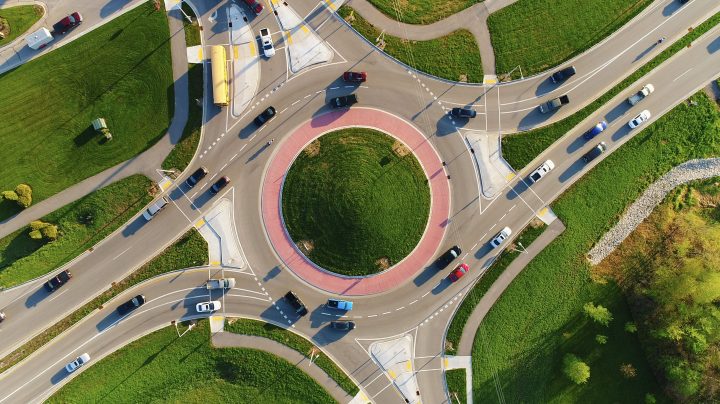
Don’t panic, it’s just a roundabout

Not all circular traffic medians were created equal. On the road, there are three types: a rotary, a traffic circle and — the safest among them — the roundabout. But in the U.S., adopting this spacious traffic control has been contentious, with only 8,800 roundabouts currently, compared to the more than 250,000 traffic signals. But out in the suburbs, roundabouts are quietly having their moment.
Andrew Van Dam of The Washington Post reported on current state of roundabouts in the U.S. and talked with “Marketplace” host Kai Ryssdal about the suburban roundabout haven that is Carmel, Indiana.
The following is an edited transcript of their conversation.
Kai Ryssdal: Do me a favor and tell me the difference — we got to do some definitions here — between a traffic circle and a roundabout and I guess the other ones are rotary. How are they different?
Andrew Van Dam: So a rotary is what the older among us will be familiar with, especially from big East Coast cities. It is that gigantic circle, it’s got multiple lanes, cars are often changing lanes inside of it, and they are often entering at full speed. It is slightly terrifying and slightly off-putting. D.C. or Boston drivers will be very familiar.
Ryssdal: That is true, and continue with the definitions, please.
Van Dam: And the traffic calming circle is sort of a junior roundabout. It is the smallest round thing on a road. It’s just like a one-meter circle in the middle of a residential intersection, accompanied by stop signs, but it doesn’t have any of the traditional features of a roundabout. Now, what are the traditional features of a roundabout? Geometry! So the amazing thing about the modern roundabout, they call it, is that it has been sort of physically designed so that drivers almost cannot possibly do the wrong thing. It has splitter islands to force them to turn as they enter the roundabout. And so, it sort of forces drivers to slow down and get into the angles such that it’s really hard to get in a fatal accident. The other innovation, though, is actually one of behavior. And that is in the modern roundabout — you always yield to traffic already in the roundabout.
Ryssdal: So, look, I mean, it does kind of seem that Americans don’t do these circular traffic patterns as well as, say, the Brits do, right? Because we imported this general concept from them.
Van Dam: Exactly. And there were some early struggles. There were some false starts such as rotaries, but I’ve heard from folks in roundabout-heavy cities who say that, yes, there was a little reticence at the beginning, we were a little bit skeptical. But man, once you figure these things out, they’re efficient, they’re smooth, and you’re never backed up behind a stoplight. It’s fantastic.
Ryssdal: Tell me about Carmel, Indiana, would you?
Van Dam: Oh, yeah. So Carmel, Indiana — which they will be delighted to tell you is pronounced ‘KAHR-muhl’ — they will say there are 12 Carmels in the United States, and only one Carmel-by-the-Sea in California is pronounced weird. But Carmel, Indiana, is easily the roundabout capital of the country. No matter how you slice and dice the data, you cannot avoid Carmel, Indiana, because of Mayor Jim Brainard. He had been to Britain. He had seen roundabouts, and he thought, “Jeez, maybe this is gonna work in Indiana.” They were almost completely unknown, and he single-handedly — basically through force of will — has built now 140 of them in Carmel. When he’s done, because he’s leaving office next year, the city will be on track to have just one single traffic signal left in the entire town. And it just happens to be one of the very first traffic signals in the entire country. So, I don’t know, seems like they felt like they couldn’t take that one out. There’s a bit of sentimental attachment to that old thing; that, a relic of history.
Ryssdal: Let’s do a little public service journalism on the way out as you approach a roundabout: What are the rules?
Van Dam: Yield! The rule is yield, both to of course pedestrians and to vehicles already in the roundabout, and the other obvious rule is please go right.
Ryssdal: Yes, that’s the obvious rule. Sorry. I didn’t know we needed to say that.
There’s a lot happening in the world. Through it all, Marketplace is here for you.
You rely on Marketplace to break down the world’s events and tell you how it affects you in a fact-based, approachable way. We rely on your financial support to keep making that possible.
Your donation today powers the independent journalism that you rely on. For just $5/month, you can help sustain Marketplace so we can keep reporting on the things that matter to you.











